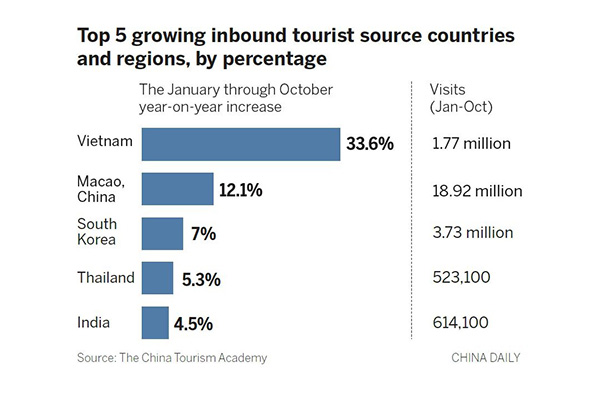
Top 5 growing inbound tourist source countries and regions, by percentage.
China’s struggling inbound tourism industry has shown signs of rebounding, a new report says.
The report, released on Dec 7 by the China Tourism Academy, a think tank under the China National Tourism Administration, looked at inbound tourism from January to October. It said the total visits made by overseas tourists in the 10-month period surpassed 100 million, an increase of 4.4 percent compared with the same period last year.
Total revenue from inbound tourism in the first 10 months reached $47.4 billion, an increase of 0.9 percent. Foreign visitors spent $28.5 billion.
Dai Bin, president of the China Tourism Academy, said the report confirms his assessment of last month, when he said, “The continuing down ward trend has been contained and China will see positive growth both in inbound tourist visits and expenditures by the end of this year”.
During the period of the 12th Five-Year Plan (2011-2015), China’s inbound tourism industry has seen three years of declining overseas visits. After slight growth in 2011, the next three years saw consecutive declines of up to 2.51 percent in the number of overseas visits.
Overseas visitors from Hong Kong, Macao and Taiwan contributed to the rebound, accounting for about 80 percent of the total inbound visits. South Korea, Japan and Vietnam ranked as the top three source countries by the numbers of inbound visits. The biggest increase was in visits from Vietnam, which increased by 33.6 percent in the 10 months.
During the same period, visits by Russian tourists fell by 27.6 percent.
Nguyen Thi Bich Hang, a Chinese translator in Hanoi, Vietnam, said Vietnamese tourists like to travel in China, especially during the Spring Festival period. “China and Vietnam share a common culture. Vietnamese tourists are attracted by the magnificent landscape of China.
“The marketing and promotion campaigns by Chinese travel agencies have worked. It is very cheap to travel in China right now. A seven-day trip to Beijing, Shanghai and Hangzhou, Zhejiang province, only costs 4,600 yuan ($718),” she added.
